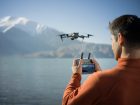
The shocking attempt on former President Donald Trump’s life on July 13 at a rally in Butler, Pennsylvania, has been the focus of intense investigation. This week, FBI Director Christopher Wray shared critical updates during a House Judiciary Committee hearing, offering insights into the mind of the gunman, Thomas Matthew Crooks, and the role a DJI drone played in his plan.
Crooks, a 20-year-old with no prior criminal record, exhibited an unusual level of planning before the attack. One chilling detail revealed by Wray was Crooks’ search history. On July 6, just days before the rally, Crooks searched online for “how far away was Oswald from Kennedy,” referencing the assassination of President John F. Kennedy in 1963. This search coincided with Crooks’ registration to attend the Trump rally, suggesting a disturbing premeditation.
On the day of the rally, Crooks flew a DJI drone around the event site for around 11 minutes, capturing footage from approximately 200 yards away. The drone, which was later found in his car, provided him with a bird’s-eye view of the surroundings.
“We believe he was live-streaming the footage, as there’s no recording of what he saw during those 11 minutes,” Wray said. “We’re still trying to determine exactly what he could see from the drone’s flight pattern and capabilities during that time.”
Nonetheless, investigators who “reverse-engineered the flight path of the drone from the day of the rally” are convinced the drone footage offered Crooks a tactical advantage. As Wray pointed out, “The drone would have given him a vantage point looking back towards the podium, almost like a rear-view mirror of the scene behind him.”
Also see: DJI Neo drone hits FCC database amid spy video, price leaks
Crooks’ attack plan also included multiple explosive devices and a collapsible-stock AR-style rifle, originally purchased legally by his father. The details were meticulously executed, but Crooks’ ability to carry out the attack was thwarted by the Secret Service. He managed to fire at least eight shots before a sniper neutralized him. Unfortunately, one rallygoer was killed, two others were wounded, and Trump sustained an injury to his ear.
The investigation into Crooks’ motive has been ongoing and challenging. Wray mentioned the FBI’s extensive efforts, including analyzing Crooks’ phone and computer, to uncover a clear rationale behind his actions. However, the search for a motive remains elusive, with no significant clues emerging so far. Despite Crooks’ interest in public figures, investigators have found no evidence of ideological extremism.
In addition to the drone and explosives, the FBI recovered 14 firearms associated with Crooks and his family. The investigation has revealed that Crooks was an avid shooter, frequenting gun ranges, including a visit the day before the assassination attempt.
During the hearing, lawmakers expressed frustration over unanswered questions, particularly regarding the role of law enforcement in monitoring Crooks before the shooting. Pennsylvania State Police Commissioner Christopher Paris testified about the officers’ actions, indicating that Crooks was on their radar before the shooting occurred. However, critical gaps in communication and coordination allowed Crooks to evade capture until the last moment.
Secret Service turned down local drone support before Trump attack
Another new detail in the case has been revealed by Senator Josh Hawley’s letter to the Department of Homeland Security (DHS). The letter comes after a whistleblower contacted his office, alleging that Secret Service officers at the rally refused to deploy drones to secure the rally before it began.
“According to one whistleblower, the night before the rally, the US Secret Service repeatedly denied offers from a local law enforcement partner to utilize drone technology to secure the rally. This means that the technology was both available to the Secret Service and able to be deployed to secure the site. Secret Service said no,” Hawley wrote.
Later, the Secret Service then “changed course” and “asked the local partner to deploy the drone technology to surveil the site,” but only in the aftermath of the attack.
Read more: Canada kicks out two after drone spying scandal at Paris Olympics
FTC: We use income earning auto affiliate links. More.






Comments